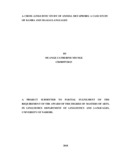| dc.description.abstract | This research study presents a comparative analysis of animal metaphors from the Kamba
and Maasai languages. The research study endeavors to find out how cultural background
contributes to shared and divergent views of the same animal metaphor in the two cultures.
The research used Fillmore Frame Theory in the analysis of animal metaphors. Animal
metaphors in the Maasai and Kamba cultures are commonly used to connote negative
meaning although a few depicts positive qualities. The findings of this study indicated that
both Kamba and Maasai cultures have animal metaphors that are similar for instance in
both cultures there are metaphors drawn from lion, elephant, donkey, wasp and dogs among
others. Among the shared metaphors there are those that have the same interpretation in
both cultures for example metaphor on elephant which means huge and energetic and
metaphor drawn from wasp which means aggressive and violent. Other metaphors are
similar but are conceptualized differently for example metaphor drawn from a cow in
Maasai means a respected person because a cow is the main source of food while in Kamba
it means a stupid person since it is basically used to assist in tasks like farming, this
therefore raises the question of intercultural miscommunication. The other category of
animal metaphors discovered in this study is observed to be culture specific it is as a result
of the distinct differences in the living environment of the two communities, among the
Maasai there are more animal metaphors drawn from wild animals like giraffe, eland, wild
dog and chameleon. On the other hand the Kamba have animal metaphor inspired by
farming drawn from cock, caterpillar, raccoon, robin among others. Verbal metaphors are
also found in the two cultures. Verbal metaphors in both communities are universal while
others are culture specific. In both cultures these metaphors do not have similar
interpretation due to the differences in cultural beliefs and attitude upheld by members of
the two communities both have metaphors derived from the verb to roar, in the Maasai it
means to boast for no reason while among Kamba it is to warn. The research has concluded
that different interpretation of same animal metaphor leads to miscommunication among
native speakers of the two speech communities | en_US |



